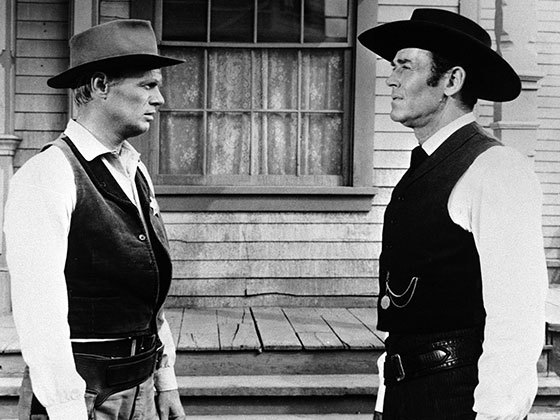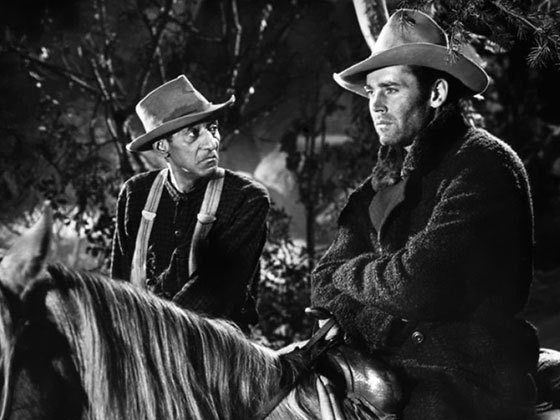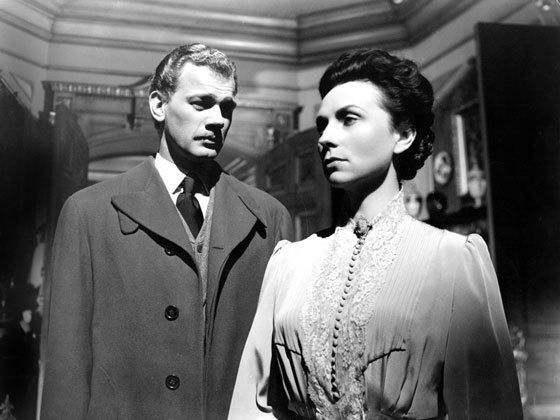By Carrie Rickey
Reimagining the serial killer of Dorothy B. Hughes’s novel as a screenwriter with anger management issues, director Nicholas Ray created something equally unnerving—and gave Humphrey Bogart and Gloria Grahame the most challenging roles of their careers.
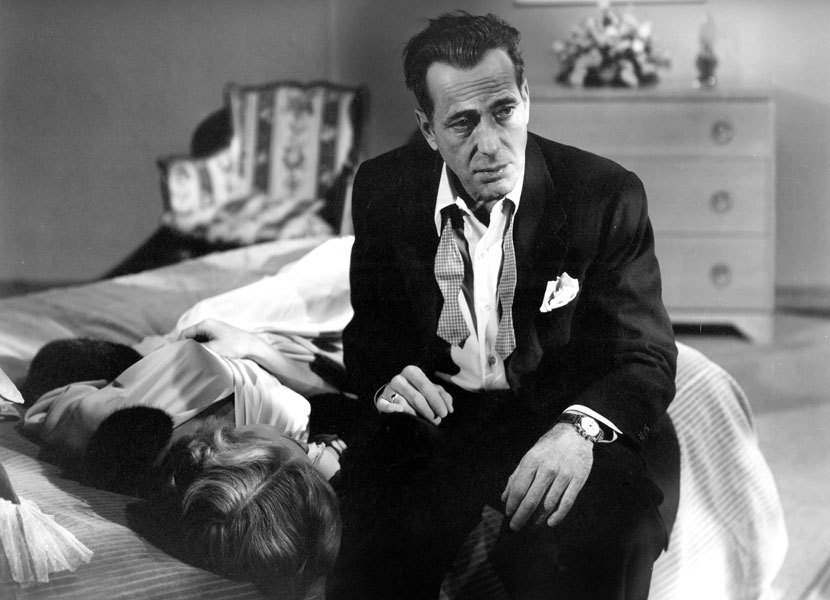
“All you gotta do is follow the book,” says the Hollywood agent to client Dix Steele (Humphrey Bogart), a screenwriter hired to adapt a bestseller in Nicholas Ray’s In a Lonely Place. For those familiar with Ray’s film and the Dorothy B. Hughes novel on which it is based, the agent’s advice ranks high on the list of Meta Moments in Movies.
Ray and screenwriter Andrew Solt decidedly did not follow the book. They couldn’t. Hughes’s book about a World War II flyboy, now a serial rapist and murderer, would have violated just about every commandment in the Production Code. Still, two prior Hughes novels, Ride the Pink Horse and Fallen Sparrow, had been successes when adapted to screen. So Ray and Solt reconceived Hughes’s account of a serial killer into the story of a war vet, scriptwriter, and volatile alcoholic with a history of assault, suspected of strangling to death a hatcheck girl.
The novel’s first-person narration tells us early on that Dix is a sociopathic killer; the suspense comes from whether he will be caught. In the movie, the suspense comes from whether he is a sociopath, this man who embraces his beloved as though he is about to strangle her.
| READ THE NOVEL |
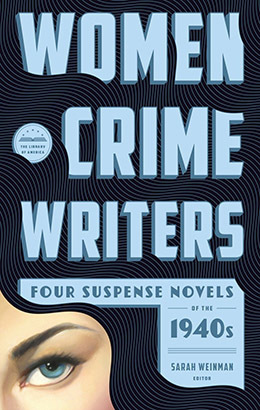 |
| Women Crime Writers: Four Suspense Novels of the 1940s |
While book and movie share few obvious similarities, their less obvious correspondences take both reader and viewer to the same lonely place. As in so many films noirs, the characters are still reeling from the disruptions of World War II. While struggling to find their feet, they remain pessimistic, darkly expecting another event will shake things up again. The novel came out in 1947, shortly after the war; the movie in 1950, as the House Un-American Activities Committee (HUAC) investigations ruptured Hollywood. In both book and movie, Dix is still fighting the war—on two fronts: against his violent impulses and against women.
For Hughes’s Dix Steele, women in general have replaced the Fascists as the Enemy. For Ray’s misanthrope, it is one woman in particular—Laurel Gray—who begins as his ally and becomes, he believes, his betrayer.
“In a Lonely Place . . . gave [Bogart] a role that he could play with complexity,” observed Louise Brooks, recognizing how his performance blurred the boundaries between role and man. To her, Dix’s “pride in his art, his selfishness, his drunkenness, his lack of energy stabbed with lightning strokes of violence were shared by the real Bogart.” When In a Lonely Place was made, Bogart was at the pinnacle of his career, poised between his Philip Marlowe in The Big Sleep and Captain Queeg in The Caine Mutiny. Dix is a potent highball of Marlowe’s wryness and Queeg’s madness.
Bogart not only starred in the film, but his production company, Santana, had brought the project to Columbia Pictures. So for him the film was doubly personal. For Ray and Gloria Grahame—his real-life wife, who played Laurel—it was even more so.
Even though Dix on the page of the novel is probably half of Bogart’s age (51), the way Hughes describes him suggests that Bogart was her model. She conjures the way Dix’s “head darted around to vent his scowl,” how “anger plucked at his face,” how it “beat him like a drum.”
Hughes told an interviewer that had she cast the film she would have advocated for Bogart’s wife, Lauren Bacall, to play Laurel. Ginger Rogers, however, was Bogart’s first choice. Ray couldn’t imagine the comedienne and dancer in the role. Bogart’s second choice was Bacall, then under contract to Warner Brothers, which refused to lend her to Columbia. Ray, whose marriage to Grahame was troubled, half-jokingly said to Bogart that it might save his marriage if his own mercurial spouse played Laurel.
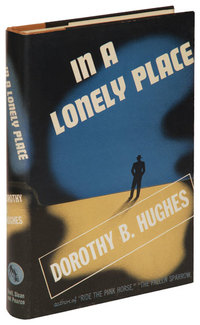
While hiring Grahame did the opposite of shoring up the collapsing Ray union, their marriage was mined for considerable effect in Ray’s contributions to the screenplay. “It wasn’t hard for the director,” wrote Ray biographer Patrick McGilligan, “. . . to view the tortured writer Dix as a crazy-mirror version of himself.” With Grahame in the front of the camera and Ray behind, how could the director resist projecting his own failing marriage onto the psychodrama and mutual paranoia of the lead characters?
Not only did Hughes seem to have Bogart in mind when she wrote Dix, her Laurel—as seen through Dix’s ogling eyes—is a dead-ringer for Grahame. In the book Dix itemizes Laurel’s infinite attractions: her insolence, the lift of her breasts, the curve of her hips. And these:
Her eyes were slant, her lashes curved long and golden dark.
Her mouth was too heavy with lipstick, a copper-red mouth, a sultry mouth painted to call attention to its premise.
She walked like a model, swaying her small buttocks. She had exquisite legs.
Perhaps the only one of Grahame’s attributes not inventoried in the novel is that playful left eyebrow punctuating Laurel’s archness.
Naturally, Bogart the producer was concerned that the fault lines in the Ray marriage might give way to earthquakes on set. But his director concocted an unusual insurance policy to prevent that from happening. He wrote a “Mr. and Mrs. Contract” stipulating that Grahame agree that “my husband shall be entitled to direct, control, advise instruct and even command my actions during the hours 9 am to 6 pm everyday except Sunday, during the filming.” A clause forbade her to “nag, cajole, tease, or in any feminine fashion seek to distract or influence him.” In other words, on the set the director sought to control Grahame as in the script Dix attempts to control Laurel.
It’s hard to imagine anyone other than Bogart and Grahame in the movie that gave them their most challenging roles and in which they gave their career-best performances.
The opening sequence establishes Dix’s (and thus the film’s) Jekyll-and-Hyde mood swings. As George Antheil’s score veers between the anxious and the romantic, Dix drives down Beverly Boulevard in his convertible, stopping for a red light. While waiting for the green, an actress in the next car recognizes Dix, and engages him in pleasantries. When her husband demands that Dix stop talking to his wife, at first Dix trades insults with him and then, in the blink of an eye, is ready to trade blows. This glimpse of Dix’s temper is the overture to the opera of fury that ensues.
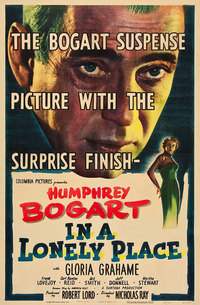
Everything sets him off, whether it’s a pragmatic director with insufficient respect for Dix’s art or a pushy producer who insults a sozzled Shakespearean actor to whom Dix gives handouts. The segues between Dix’s sociability and sociopathy are deeply unsettling. And as every time Dix goes bonkers, Burnett Guffey, the cameraman, positions the key light in Bogart’s eyes, Dix may well be more threatening even than Mr. Hyde.
Not to put too fine a point on it, Dix is a misanthrope who majored in misogyny. He exudes contempt for most women, whether it’s for the hatcheck girl he asks to summarize the novel he’s been hired to adapt or the ex-girlfriend who slides into his restaurant booth to invite him over for a nightcap. When Dix sneers at her overture, the ex says with a sigh, “Do you look down on all women, or just the ones you know?”
As Dix listens to the hatcheck girl scrambling the plot of the page-turner, he can’t know that he’s about to live through the narrative she recounts. The book is about Althea Bruce, a wealthy woman under investigation for her husband’s mysterious death. She meets a handsome lifeguard and enjoys “the dreamy weeks” of their affair before it all goes south. The keen viewer will recognize Dix in Althea and Laurel Gray in the handsome lifeguard. Oh yes, there’s an unsolved murder of which Dix is a prime suspect. Laurel tells police Capt. Lochner (Carl Benton Reid) that at the time of the murder she saw Dix in his apartment. She provides Dix with his alibi. Their flirtation begins, in all places, at the police station while Dix endures Lochner’s third degree.
The film’s chief attraction is how Dix and Laurel express theirs. Not only do they have chemistry, they have physics and biology, too. At the station house, where these neighbors at a hacienda-style courtyard apartment are formally introduced, Lochner asks Laurel why she noticed Dix in the first place. “I liked his face,” she says. Later, back in the courtyard, they trade appraising looks. He moves in for a kiss and she rebuffs him. “I said I liked your face,” she asserts, firmly. “I didn’t say I wanted to kiss it,” further piquing Dix’s interest.
For Dix, Laurel is the girl who’s different—not coy, cute, or corny, he says, appreciatively. When Dix confesses that he is a serial killer—but only in movie scripts, they laugh. At last, they do kiss and it’s as if Laurel, Sleeping Beauty, and Dix, Sleeping Broody, wake each other up. Cue “the dreamy weeks.” With Laurel as his muse, Dix writes through the night and she types up the pages each morning.
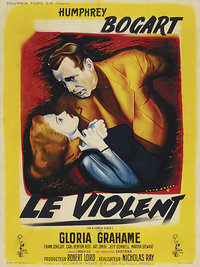
They get cuddly at piano bars, canoodle at the beach, and share cozy breakfasts. Dix’s joy in the relationship is palpable in his writing. But the rhythms of their relationship unsettle Laurel. When everything seems idyllic, Dix erupts into a volcanic rage. He’s paranoid about the ongoing murder investigation. He worries that he’s being followed, and is deeply suspicious that Laurel is about to leave him, as the lifeguard in his screenplay leaves the heroine. After one such eruption, Dix rehearses some lines he’s written, ones that will turn up in the denouement of his screenplay as well as that of the film: “I was born when she kissed me. I died when she left me. I lived a few weeks while she loved me.” Dix doesn’t know where to fit them in the script, he tells Laurel. (According to Ray’s biographer, the director wrote these memorable lines.)
Ray’s improvisation with the actors served as the script’s final draft. The finale, in particular, went through a startling transformation. In Solt’s original screenplay, Dix becomes maniacally possessive and Laurel, popping pills for anxiety and insomnia, suspects that he really might have murdered the hatcheck girl. Feeling cornered, imagining the police are closing in and that Laurel is leaving him, Dix strangles her and returns to his typewriter to finish off the screenplay as the police come in to find her corpse. Ray shot this fraught scene. However much he may have wanted to get rid of Grahame, it felt wrong—narratively and, perhaps, morally. Too on-the-nose?
During the shoot Ray encouraged Bogart and Grahame to improvise, all the better to unconsciously reveal facets of the characters they played. With them Ray reworked the finale. If you haven’t seen the film, read no further. Realizing that Laurel is about to leave him, Dix throws her on the bed and begins to strangle her. The phone rings and Dix relaxes his grip on Laurel’s throat in order to answer it. Limply, he listens to the caller, and then thrusts the receiver at Laurel, telling her, “A man wants to apologize to you.” The police detective informs Laurel that Dix is cleared, the hatcheck girl’s killer has confessed.
While keeping the homme fatale at the center of Hughes’s novel, Ray shocked viewers with a denouement possibly creepier than that of the book. In the novel Dix is a remorseless, cold-hearted killer. In the movie, though, he is equally capable of love as well as murder. For those who long to see the misanthrope redeemed by love (and really, who does not?), it is Dix’s killing off his love affair that cuts to the quick. His remorse is almost unbearable.
At the film’s anticlimax Dix skulks off as Laurel watches him disappear into the shadows. “I lived a few weeks while you loved me,” she murmurs, paraphrasing Dix’s lines that have, at last, found their right place in the story.
Video: 1950 trailer for In a Lonely Place (2:27)
In a Lonely Place. (1950) Directed by Nicholas Ray. Written by Andrew Solt, from Dorothy B. Hughes’s novel. With Humphrey Bogart, Gloria Grahame and Frank Lovejoy.
Buy the Criterion Collection DVD • Buy the Criterion Collection Blu–Ray • Watch on Amazon Video • Watch on iTunes • Watch on Vudu
Carrie Rickey, longtime film critic for The Philadelphia Inquirer, writes for Yahoo! Movies and Truthdig.com on subjects related to film. Essays of hers are collected in The Rolling Stone Illustrated History of Rock and Roll and the Library of America anthology American Movie Critics.
The Moviegoer showcases leading writers revisiting memorable films to watch or watch again, all inspired by classic works of American literature.


